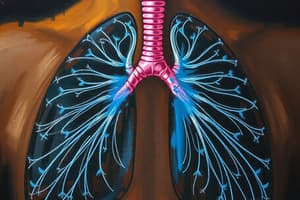Podcast
Questions and Answers
Which drug classifications are respiratory drugs? (Select all that apply)
Which drug classifications are respiratory drugs? (Select all that apply)
- Expectorants (correct)
- Antitussives (correct)
- Decongestants (correct)
- Bronchodilators (correct)
- Antihistamines (correct)
Which conditions are respiratory medications used to treat? (Select all that apply)
Which conditions are respiratory medications used to treat? (Select all that apply)
- Asthma (correct)
- Chronic obstructive pulmonary disease (COPD) (correct)
- Allergies and hay fever (correct)
- Emphysema and chronic bronchitis (correct)
Which bronchodilator should be used as a rescue inhaler and not as a daily medication to prevent shortness of breath?
Which bronchodilator should be used as a rescue inhaler and not as a daily medication to prevent shortness of breath?
Short-acting inhaled beta2-agonists
Match the respiratory drug classification to the therapeutic effect.
Match the respiratory drug classification to the therapeutic effect.
Drag each drug to its correct classification.
Drag each drug to its correct classification.
What classification of Valine's prescribed respiratory medication should she use now after experiencing symptoms?
What classification of Valine's prescribed respiratory medication should she use now after experiencing symptoms?
Long-acting Beta2 Agonists actions and side effects of beta-adrenergic agonist (beta-blockers) will mimic the _________ nervous system.
Long-acting Beta2 Agonists actions and side effects of beta-adrenergic agonist (beta-blockers) will mimic the _________ nervous system.
Mast cell stabilizers are prescribed for exercise-induced _________.
Mast cell stabilizers are prescribed for exercise-induced _________.
Match the drug with its classification.
Match the drug with its classification.
Drag the correct drug to match its effect on the nervous system.
Drag the correct drug to match its effect on the nervous system.
What is the first action to take when assessing a patient for respiratory treatment?
What is the first action to take when assessing a patient for respiratory treatment?
Which drug is contraindicated in narrow-angle glaucoma, uncontrolled cardiovascular disease, hypertension, diabetes, and prostatitis?
Which drug is contraindicated in narrow-angle glaucoma, uncontrolled cardiovascular disease, hypertension, diabetes, and prostatitis?
What is one of the most common adverse effects that occurs with antihistamines that may result in poor use?
What is one of the most common adverse effects that occurs with antihistamines that may result in poor use?
Flashcards are hidden until you start studying
Study Notes
Drug Classifications
- Bronchodilators, antihistamines, expectorants, antitussives, and decongestants are key respiratory drug classes.
Conditions Treated
- Respiratory medications are used to treat allergies, hay fever, COPD, asthma, emphysema, and chronic bronchitis.
Rescue Inhaler
- Short-acting inhaled beta2-agonists are designated for immediate relief and not for daily maintenance.
Drug Classification Effects
- Antihistamines relieve allergic symptoms.
- Decongestants reduce nasal congestion.
- Antitussives suppress cough reflex.
- Expectorants facilitate mucus clearance.
- Bronchodilators expand airways by relaxing lung muscle.
Drug Examples by Classification
- Antihistamines: loratadine, fexofenadine.
- Decongestants: fluticasone, triamcinolone.
- Antitussives: codeine, dextromethorphan.
- Expectorants: guaifenesin.
Immediate Action for Asthma
- Valine should use short-acting inhaled beta2-agonists to address acute asthma symptoms.
Beta-Agonists and Nervous System
- Long-acting beta2 agonists mimic sympathetic nervous system actions.
Mast Cell Stabilizers
- These agents are infrequently prescribed and are mainly indicated for exercise-induced asthma.
Classification of Respiratory Drugs
- Theophylline belongs to xanthine derivatives.
- Short-acting beta agonists (SABA) include levalbuterol and terbutaline.
- Long-acting beta agonists (LABA) consist of salmeterol and formoterol.
- LABA plus corticosteroids include combination products like Advair or Symbicort.
- Anticholinergic drugs include ipratropium and tiotropium.
- Inhaled corticosteroids include beclomethasone, budesonide, fluticasone, and triamcinolone.
- Mast cell stabilizers are cromolyn and nedocromil.
- Leukotriene receptor antagonists encompass montelukast and zafirlukast.
Nervous System Effects
- Beta-adrenergic agonists mimic sympathetic nervous system activity.
- Anticholinergic drugs block acetylcholine in the parasympathetic nervous system.
Patient Assessment Steps
- Gather patient's medical history and current medications.
- Perform a comprehensive physical assessment.
- Identify potential causes or risk factors related to respiratory issues.
- Conduct inquiries regarding previous substance use such as alcohol or CNS depressants.
Contraindications and Effects
- Decongestants are contraindicated in certain medical conditions like glaucoma and cardiovascular diseases.
- Efficacy of some expectorants is inconclusive compared to water.
- Antihistamines can enhance the effects of other CNS depressants.
- Antitussives may increase sedation risk with concurrent medication use.
Mechanisms of Action
- Anticholinergics block acetylcholine to prevent bronchial constriction.
- Mast cell stabilizers prevent histamine release.
- Antihistamines soothe membranes and reduce inflammation.
- Leukotriene receptor antagonists inhibit inflammatory mediators in asthma management.
Common Adverse Effects
- Drowsiness is a prevalent side effect of antihistamines that can lead to reduced adherence to medication.
Monitoring
- Monitor interactions with opioid medications and assess airway secretions.
- Blood pressure should be closely observed in patients taking certain respiratory drugs.
Studying That Suits You
Use AI to generate personalized quizzes and flashcards to suit your learning preferences.




